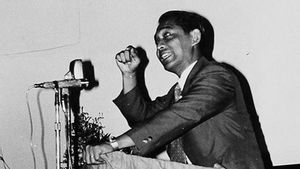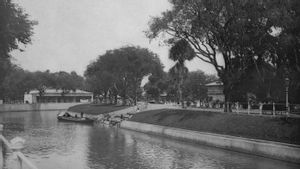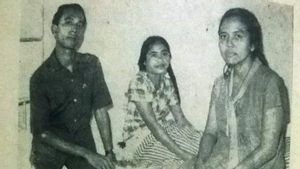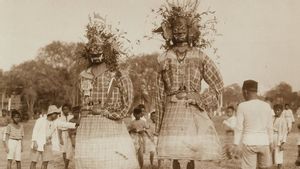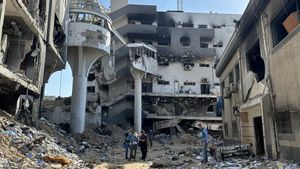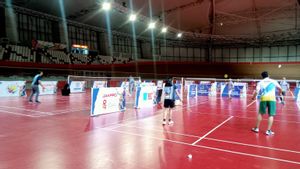JAKARTA - Soekarno is good at taking advantage of the momentum. The relocation of the capital city from Yogyakarta to Jakarta was his aim to build Jakarta. He promoted lighthouse politics. The project not only made workers come to Jakarta but also gave rise to a trend of impromptu food stalls for workers, pioneered by traders from Tegal. The name is Warung Tegal (warteg).
Diplomacy was once the backbone of Indonesia in locking up independence. The Round Table Conference which was held from 23 August to 2 November 1949 was decisive. The Indonesian delegation was led directly by Mohammad Hatta, the Netherlands was represented by van Maarseveen, and the Federal Consultative Assembly (BFO) was led by Sultan Hamid.
The big victory was obtained by Indonesia through the KMB. The conference produced the Charter of Surrender of Sovereignty. A charter stipulates that the Netherlands must recognize Indonesia's sovereignty as a state.
The Netherlands was also asked to hand over power to Indonesia no later than December 30, 1949. This means that the transfer of power will be carried out immediately without going through a transition process, as previously determined. The Netherlands also obeyed the results of the KMB.
Thus, the Netherlands officially recognized Indonesia's independence on 27 December 1949. The transfer of sovereignty ceremony was held in two places: Gambir Palace (Jakarta) and Dam Palace (Amsterdam). At that time, for the last time, the Red-White-Blue Flag was entrenched at the top of the Gambir Palace building (now: Merdeka Palace). The flag was changed to the Indonesian flag: Red and White.
“The ceremony for the transfer of sovereignty took place on 27 December 1949 simultaneously, in Amsterdam and in Jakarta: At the Paleis op de Dam, witnessed by Queen Juliana, Moh. Hatta – RIS PM- signed the sovereignty transfer document."
“In Jakarta, Sultan Hamengku Buwono IX, as the Minister of Defense of the RIS, accepted the transfer of sovereignty from the Deputy Crown Agung of the Netherlands, Dr. AH.J. Lovink. Hatta later said that in his life there were two peak moments that satisfied him. First, as the proclaimer of the independence of the Indonesian people on August 17, 1945. Second, as the representative of the Indonesian nation, he signed a document of recognition by the Dutch,” said Rosihan Anwar in Sutan Sjahrir's book: True Democrat, Fighter for Humanity, 1909-1966 (2010).
The transfer of sovereignty prompted another major event. The incident made the capital city of Indonesia, which had been moved to Yogyakarta, finally returned to Jakarta. This momentum has the support of all Indonesian people. Including Sukarno. Even though he was reluctant to admit the surrender of Indonesian sovereignty because he thought that Indonesia had been independent since August 17, 1945.
The return of Jakarta as the capital city made Soekarno's soul as an architect light up. The lighthouse project is underway. For the sake of beautifying Jakarta, he said. Jakarta was then regarded as a beacon of the nation's struggle. Which is, Jakarta must have an identical character similar to the flame of revolution.
Monuments that ignite the spirit of the people on the battlefield were reproduced. Hero Statue, Aerospace Statue, Welcome Statue, and National Monument. Likewise with the new residential complex is allegedly a sign that Jakarta is starting to develop rapidly.
“New settlements have continued to grow here since the 1950s, then expanded in the 1960s. Many areas that used to be green have turned into dense settlements, for example, the area around the Menteng Atas cemetery. On the edge of Jalan Saharjo, near the Red Bridge to the Menteng Pulo cemetery, for example, which in the 1950s was still a garden, has grown into housing and a market in the 1960s.”
“Tebet and Pal Batu grew into new housing estates in the 1960s. At this time, Tebet was indeed a shelter for residents who were moved from the Senayan village due to the construction of the Senayan sports complex for the Asian Games around the late 1950s or early 1960s," wrote Firman Lubis in his book Jakarta 1950-1970 (2018).
The trend of warteg

A series of developments that impact on many things. Urbanization is one of them. Workers, mainly from Central Java, started arriving in Jakarta. They then fulfill projects in remote areas of the capital.
His arrival turned out to be an opportunity for immigrants from Tegal. Those who come to Jakarta with their families are keen to see opportunities. The husbands work as construction workers. Meanwhile, his wife helps her husband increase his income.
Selling food in the stalls at each project site is a practice for the wives. Because a large number of construction workers definitely need food at affordable prices. Therefore, many stalls with the acronym Warteg were born.
“At that time these stalls were filled with Tegal people, now this warteg is a marker because those who sell Tegal people are known as such. At that time there were also many phenomena like this, barbers from Garut, that's why it was known that barbers were identical with Garut. This is because there are many ethnic groups who do this work,” explained historian JJ Rizal as written by Kompas.com.

After that, Warteg was present almost everywhere. From every street, from an ojek stand, a trishaw stand, or tucked away between the tents of other food vendors. All kinds of side dishes are placed in a glass box that extends on the table. The side dishes are dominated by processed vegetables, fish, or meat. Customers keep coming. So are the advantages.
Warteg also reached its peak in the capital city in the 1950s. Or right at a time when the urbanization rate is at its highest. At that time, warteg could sell one quintal of fried cassava a day. The turnover is quite large. Besides being able to finance family life, warteg traders can build houses, even the economy in their hometown, Tegal.
“Warteg Warno's turnover in the early 1980s was around Rp25 thousand a day. Warno heads the 17-member family in the two-story plank house, which is also the selling point. This 59-year-old man often remembers his heyday in the 1950s when his warteg could sell one quintal of fried cassava a day.”
“He is one of the pioneers of warteg in Jakarta – along with Karsiwan, who opened a shop in the Grogol area before the Japanese occupation. Warno has opened his shop in Kemayoran since 1948. All of his brothers and their 13 children also work in the field of warteg. Some of their children were born in his shop,” concluded the Tempo Magazine report entitled Warung Tegal Merambah Ibu Kota (2012).
*Read other information about JAKARTA HISTORY or read other interesting articles from Detha Arya Tifada.
Other MEMORY
SEE ALSO:
The English, Chinese, Japanese, Arabic, and French versions are automatically generated by the AI. So there may still be inaccuracies in translating, please always see Indonesian as our main language. (system supported by DigitalSiber.id)



